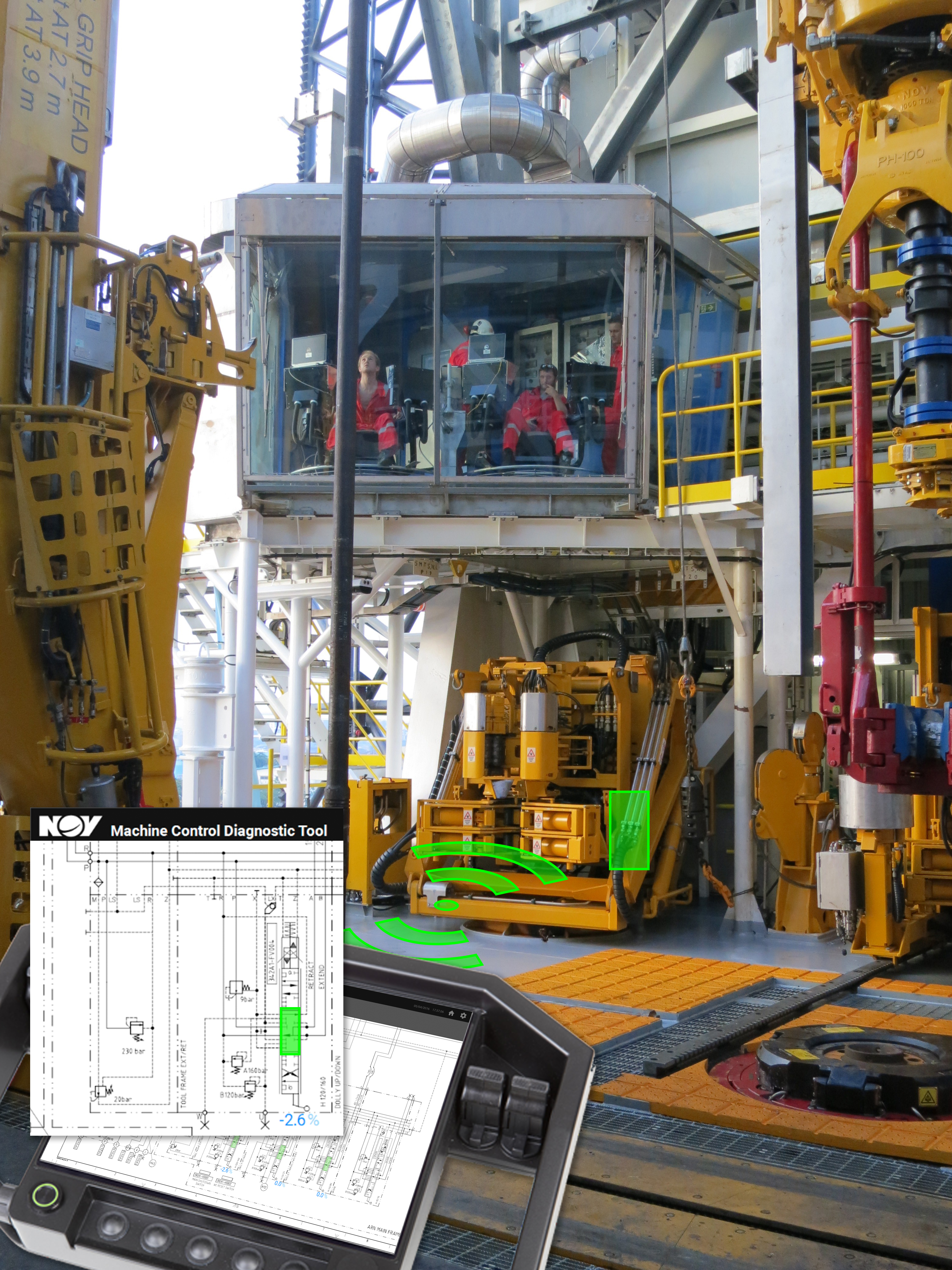Opportunities to integrate equipment and systems in innovative ways are enabling further gains that simply were not available with conventional technologies, addressing a growing need as rig equipment becomes more and more advanced and automated. National Oilwell Varco (NOV) recently released the machine control diagnostics tool (MCDT) to support operators seeking improvements to safety, communication and decision-making.
Tool overview
MCDT is a comprehensive system that establishes a communication link between rig equipment, corresponding drawings and part numbers. The system is designed to provide rig electronics technicians and hydraulic engineers with immediate diagnostics on drilling, pipehandling and hoisting equipment. The system helps rig personnel achieve higher levels of safety, reduce risk and work better cross-functionally with other members of the crew while preventing technical issues from causing rig inefficiencies and day rate penalties. MCDT accomplishes these objectives by providing one digital platform where all information needed for equipment heath and troubleshooting is easily available and interlinked.
The system is available for drilling equipment, mud equipment and cranes, and it comes with a variety of modules to monitor and diagnose instrumentation, view documentation, provide red lines or a combination of these categories using overlay and augmented reality techniques. MCDT is also an important value add to NOV’s multimachine control concept, which allows an operator to control a suite of fully automated drilling equipment as if it were one machine. The system has recently been commercialized and the first installation completed, with early results clearly showing that the MCDT is worth the upfront cost. The benefits of the system and their positive impact on the overall drilling operation are summarized in three major categories: situational awareness, teamwork and communication, and decision-making (Figure 1).

Situational awareness. Sensors, actuators and other instrumentation are categorized by machine function, allowing a seamless transition from the operator panel to the maintenance program. There is no need for machine-specific knowledge to start the diagnostics. Additionally, the equipment alarm system presents component failure across the various modules in the MCDT. A separate alarm module helps with diagnosing and gives more specific alarms about sensor condition where possible. Categorizing the alarms helps easily identify the correct measures. The real-time control system input/ output (I/O) reader with trend functions provides important troubleshooting information, and drawings can easily be updated and even display real-time information from the control system, including process values and animated valve positions.
Teamwork and communication. Three-dimensional models highlighting equipment components help communication between team members, while having immediate access to data sheets and part numbers for each component helps team members ensure the right component is installed and reordered. By quickly identifying affected components, the relevant drawings, parts and part numbers can be located and the right crew member can begin troubleshooting. A calibration tool enables the rig crew to tune and optimize rig performance, a job traditionally performed in collaboration with original equipment manufacturer specialists.
Decision-making. A step-by-step troubleshooting guide effectively eliminates potential errors and finds root causes. Having a dedicated MCDT operator panel enables troubleshooting equipment without interrupting normal operations, in turn allowing the crew member to more effectively focus attention and energy on process execution.
Case history
A drilling contractor recently decided to install the MCDT on a deepwater drillship as part of the system’s first commercial deployment. In addition to determining whether the MCDT was a viable expense, the installation was intended to provide an opportunity for testing and feedback collection, with the intent of identifying any areas of weakness for further improvement as the system is refined. The drilling contractor noted several features that were of significant value to the operation.
The contractor first noted that the interactive piping and instrumentation diagram function, which incorporates real-time feedback, was a very useful feature. The ability to select a drawing against a signal and see in real time what was going on versus having to return to a cabinet with a set of drawings and a test meter made things much simpler and saved rig time, allowing mechanics to see pressure feedback without having to hook a pressure reader up to the ports. The I/O viewer was similarly useful due to the real-time nature of the data, with the I/O viewer allowing personnel to see things such as if the proximity switch was working correctly (Figure 2).

Putting data sheets at the user’s fingertips eliminated the need to search through drawings for information, instead allowing a simple comparison of part numbers based on the signal selected. Another functionality, the diagnostic wizard, was helpful with fault-finding, allowing possible errors to be discarded through simulation. Finally, the single-axis control function was highlighted for its ability to allow personnel to recalibrate deadband zones in a significantly safer way because no one had to be near the machinery to perform the action and more functions were available than on the traditional system. Tablet functionality for easy transport around the rig was also noted for making the system extremely convenient.
Though the drilling contractor did not establish an exact cost metric for savings using the system, the consensus was that the MCDT would break even on its upfront cost quickly. Having the MCDT in the doghouse allowed the crew to more effectively monitor and troubleshoot the equipment, see all feedback and act on it in real time and have all drawings easily accessible. The drilling contractor commented that it would recommend the MCDT to any maintenance team.
The offshore industry will continue to demand more efficient solutions to combat the natural volatility of this highly cyclical industry. Simply due to the costly nature of capital equipment, the logical solution for most companies will be to embrace technology and digitalization moving forward. Installing something like the MCDT on a rig is one step on the way.
___________________________________________________________________________________
Have a story idea for Operator Solutions? This feature highlights technologies and techniques that are helping upstream operators overcome their challenges. Submit your story ideas to Group Managing Editor Jo Ann Davy at jdavy@hartenergy.com.
Recommended Reading
Rystad: More Deepwater Wells to be Drilled in 2024
2024-02-29 - Upstream majors dive into deeper and frontier waters while exploration budgets for 2024 remain flat.
E&P Highlights: April 15, 2024
2024-04-15 - Here’s a roundup of the latest E&P headlines, including an ultra-deepwater discovery and new contract awards.
Exxon Mobil Green-lights $12.7B Whiptail Project Offshore Guyana
2024-04-12 - Exxon Mobil’s sixth development in the Stabroek Block will add 250,000 bbl/d capacity when it starts production in 2027.
Exxon Ups Mammoth Offshore Guyana Production by Another 100,000 bbl/d
2024-04-15 - Exxon Mobil, which took a final investment decision on its Whiptail development on April 12, now estimates its six offshore Guyana projects will average gross production of 1.3 MMbbl/d by 2027.
Deepwater Roundup 2024: Americas
2024-04-23 - The final part of Hart Energy E&P’s Deepwater Roundup focuses on projects coming online in the Americas from 2023 until the end of the decade.





